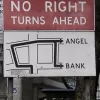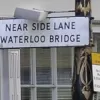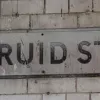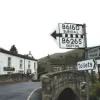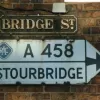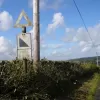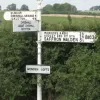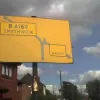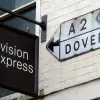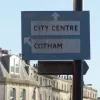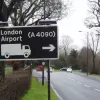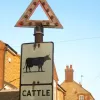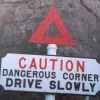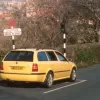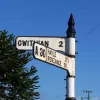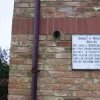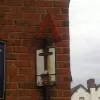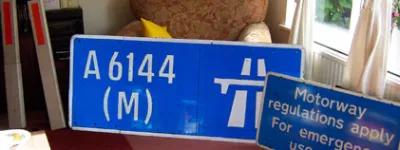Britain's current road signs were brought in around 1963. Before that time, we used a very different system of road signs, some of which still somehow survive. This page presents a number of photos of these old-style signs. Many of them have been removed since being photographed and the number of signs like these on our roads shrinks every year.
Aldwych, London
All of these signs were removed in about 2009.
Starting at the junction of Holborn and Kingsway, opposite Holborn Underground station is our first pre-Worboys direction sign. This is for traffic heading north along Kingsway. It's since been removed. Photo by Tony
One block to the south is this beauty — a sign explaining the one-way system in force at Holborn. Photo by Tony
Another lovely pre-Worboys sign, this time on a traffic island in the middle of Aldwych, on its western arm. Notice the unusual road name sign above it. It was removed in late 2009, but the semi-circular name plate above it remains. Photo by Tony
On the Strand, a sign telling people to get in lane by advising them where it goes. This sign was removed, about thirty years after the Waterloo Bridge lanes were physically separated and it became redundant. Photo by Tony
Southwark, London
In Stamford Street, heading east, at the junction with Blackfriars Bridge Road, is a pre-Worboys direction sign. Photo by Tony
Walking along Southwark Street, about 200m east of the last junction, and on the north side of the road is this old road number sign. Photo by Tony
This one is unusual in showing the previous name of the street. There is probably nobody left alive who remembers it as Worcester Street. Photo by Tony
Further east, Union Street has another number plate, but this time in white on black. In the 1920s, A-roads were signed in black on white, B-roads in white on black. This sign could be anything up to eighty years old. Photo by Tony
Here's an old street name sign that incorporates the road number. A black vertical bar separates the two (and someone has fixed a cable across the sign, over the road number!). Photo by Tony
Another example, but this time on two lines. Both this sign and the previous one include the postcode district after the road name, and this used to be painted red. Above this sign is an old-style plate indicating the presence of a fire hydrant. The more modern 71 sign is probably the bridge number. Like many other railway bridges in this part of London, the side walls are covered in white glazed tiles. Photo by Tony
Elsewhere in the country
The centre of Kettlewell, North Yorkshire. This one has clearly been added to over the years, but definitely not replaced. The stripey line means that this is the B6160 which leads to the B6265. I can't help but wonder — these signs are embossed with the letters, but the colour is just painted. Do the council still repaint them, or were they just this well made?
Not only a very nice example of an old sign, but one erected by the RAC. Before the 1963 Worboys Report the AA and RAC could put up their own signs providing they were the correct designs. Photo by Paul Berry
This is a very well preserved warning sign for a 1-in-5 hill in Dumfries — to this day, this is the only warning of the hill. Photo by Colin Robertson
If you head to the Dales and pass Dent station, you might spot this nicely preserved old West Yorkshire fingerpost. Photo by Chris Thompson
Another view of the same sign, showing that it also has a name plate attached. Peter mentions that the whole of the B1039 is scattered with these. Photo by Peter White
Not too far away is this cast iron sign, originally placed on a weak stone bridge. The bridge has long since been replaced, but the sign was retained and mounted on the railings of the new one. Ponderous carriages beware! Photo by Peter White
This local road sign is in the West Midlands. Originally the boxes within the sign would have been white-on-black, but the white paint or vinyl has long since departed. Aside from this the sign is in excellent condition, complete with a hint of a white stripe on its pole. Photo by Richard Barraclough
If you have trouble seeing this wall-mounted sign, you might like to get yourself some new glasses. Photo by Chris Beckett
On the same building as the previous picture, this sign points away at right-angles down a different arm of the junction. Photo by Chris Beckett
In Bristol the way is clearly marked by this blue-and-white local directions sign on Whiteladies Road. Photo by Colin Price
In the badlands of North-West London, Boxtree Road in Harrow Weald is home to this sign in excellent condition. Photo by Laurie Akehurst
Not far from the previous sign, this one is on the A4008 Oxhey Lane approaching the A410. No, it's not an old sign — in fact it's quite new — but its wording is bizarre. The reason is that in the very early 1960s a route was signposted through this part of London to connect the M1 with Heathrow (then called London Airport). This sign is a straight copy of one of those, without bothering to update the wording. Photo by Laurie Akehurst
Back in 1979, Ray Harrington had a vision of the future and knew this page would one day bring old road signs to the masses via an unimaginable worldwide computer network. For that reason he took this picture of a sign in Mitcham, now long gone. Photo by Ray Harrington
Another picture taken in 1979 — again featuring a personal appearance from RH White, Town Clerk. Photo by Ray Harrington
There's plenty to keep you busy on the Isle of Wight — at Carisbrooke Castle there's a bend guarded by these unique signs. They seem to have been carefully preserved and have a coat of fresh paint. Photo by Ray Harrington
The corner these signs guard has single-file traffic which is regulated by a pair of two-aspect traffic signals. They are in all probability the oldest signals on a public highway — and still going strong. Photo by Ray Harrington
This street sign hangs, forgotten, on a wall near Waterloo station in London. Photo by Ray Harrington
Not far away is another. This window must have been bricked up for quite some time. Photo by Ray Harrington
Milford-on-Sea in Hampshire is ever so slightly more picturesque thanks to this handsome and well-preserved sign. Photo by Paul Kustov
This wordy sign on Rose Court in Wokingham has been superceded by a slightly more obvious modern example, but luckily the old one has been left in place, continuing to threaten cyclists with a forty shilling fine. Photo by Richard Thompson
A more recent sign — this one dating from the 1950s rather than the 30s or 40s — again in Wokingham. Photo by Richard Thompson
Guarding this narrow and steep road are two extremely rare warning signs, complete with reflector studs on the symbols. They live in Bishop's Castle in Shropshire. Photo by Jon Hammond
Nearby in Bishop's Castle is this direction sign, looking very smart given its age. Photo by Jon Hammond
Both signs face each other across the top of the street, and make for a very handsome (and rare) sight. Photo by Jon Hammond
In the North East of England, you can still find your way to Wooler in the dark with this handsomely reflectorised old sign. Photo by John Neesom
The backstreets of Stourport-on-Severn yield this gem, complete with its red warning triangle. It could do with some restoration work. Photo by Andy
A local road near Flatford in Suffolk has a bridge which is unambiguously closed to vehicles with this vintage sign. Photo by Daniel Betts

